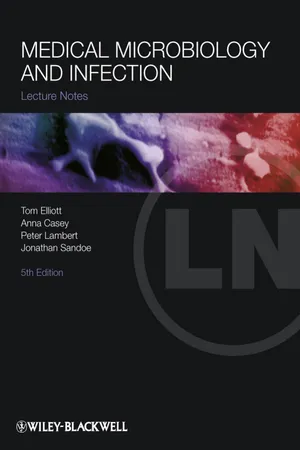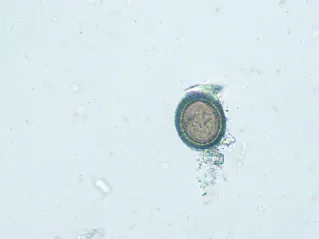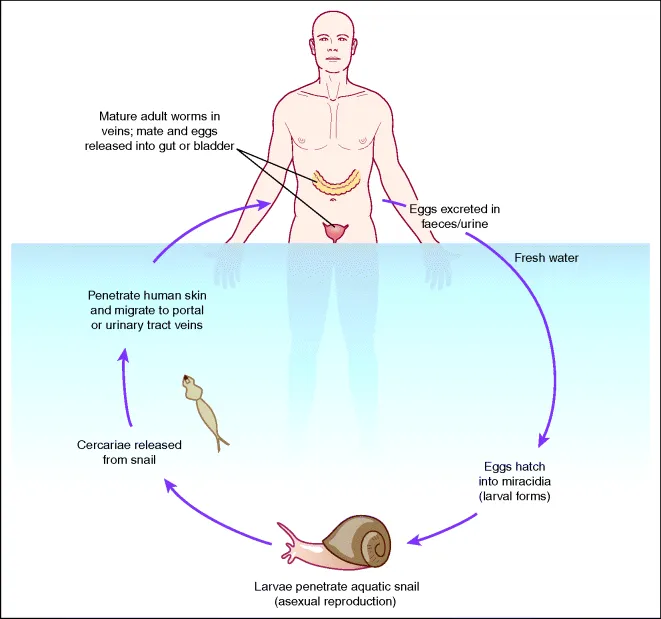
eBook - ePub
Medical Microbiology and Infection
This is a test
- English
- ePUB (mobile friendly)
- Available on iOS & Android
eBook - ePub
Medical Microbiology and Infection
Book details
Book preview
Table of contents
Citations
About This Book
Medical Microbiology and Infection Lecture Notes is ideal for medical students, junior doctors, pharmacy students, junior pharmacists, nurses, and those training in the allied health professions. It presents a thorough introduction and overview of this core subject area, and has been fully revised and updated to include:
- Chapters written by leading experts reflecting current research and teaching practice
- New chapters covering Diagnosis of Infections and Epidemiology and Prevention& Management of Infections
- Integrated full-colour illustrations and clinical images
- A self-assessment section to test understanding
Whether you need to develop your knowledge for clinical practice, or refresh that knowledge in the run up to examinations, Medical Microbiology and Infection Lecture Notes will help foster a systematic approach to the clinical situation for all medical students and hospital doctors.
Frequently asked questions
At the moment all of our mobile-responsive ePub books are available to download via the app. Most of our PDFs are also available to download and we're working on making the final remaining ones downloadable now. Learn more here.
Both plans give you full access to the library and all of Perlego’s features. The only differences are the price and subscription period: With the annual plan you’ll save around 30% compared to 12 months on the monthly plan.
We are an online textbook subscription service, where you can get access to an entire online library for less than the price of a single book per month. With over 1 million books across 1000+ topics, we’ve got you covered! Learn more here.
Look out for the read-aloud symbol on your next book to see if you can listen to it. The read-aloud tool reads text aloud for you, highlighting the text as it is being read. You can pause it, speed it up and slow it down. Learn more here.
Yes, you can access Medical Microbiology and Infection by Tom Elliott, Anna Casey, Peter A. Lambert, Jonathan Sandoe in PDF and/or ePUB format, as well as other popular books in Medicine & Infectious Diseases. We have over one million books available in our catalogue for you to explore.
Information
Part 1
Basic Microbiology
Chapter 1
Basic Bacteriology
Bacterial Structure
Bacteria are single-celled prokaryotic microorganisms, and their DNA is not contained within a separate nucleus as in eukaryotic cells. They are approximately 0.1–10.0 μm in size (Figure 1.1) and exist in various shapes, including spheres (cocci), curves, spirals and rods (bacilli) (Figure 1.2). These characteristic shapes are used to classify and identify bacteria. The appearance of bacteria following the Gram stain is also used for identification. Bacteria which stain purple/blue are termed Gram-positive, whereas those that stain pink/red are termed Gram-negative. This difference in response to the Gram stain results from the composition of the cell envelope (wall) (Figure 1.3), which are described below.
Figure 1.1 Shape and size of some clinically important bacteria.

Figure 1.2 Some bacterial shapes.

Figure 1.3 A section of a typical bacterial cell.

Cell Envelope
Cytoplasmic Membrane
A cytoplasmic membrane surrounds the cytoplasm of all bacterial cells and are composed of protein and phospholipid; they resemble the membrane surrounding mammalian (eukaryotic) cells but lack sterols. The phospholipids form a bilayer into which proteins are embedded, some spanning the membrane. The membrane carries out many functions, including the synthesis and export of cell-wall components, respiration, secretion of extracellular enzymes and toxins, and the uptake of nutrients by active transport mechanisms.
Mesosomes are intracellular membrane structures, formed by folding of the cytoplasmic membrane. They occur more frequently in Gram-positive than in Gram-negative bacteria. Mesosomes present at the point of cell division of Gram-positive bacteria are involved in chromosomal separation; at other sites they may be associated with cellular respiration and metabolism.
Cell Wall
Bacteria maintain their shape by a strong rigid outer cover, the cell wall (Figure 1.3).
Gram-positive bacteria have a relatively thick, uniform cell wall, largely composed of peptidoglycan, a complex molecule consisting of linear repeating sugar subunits cross-linked by peptide side chains (Figure 1.4a). Other cell-wall polymers, including teichoic acids, teichuronic acids and proteins, are also present.
Figure 1.4 Cell wall and cytoplasmic membrane of (a) Gram-positive bacteria, (b) Gram-negative bacteria and (c) mycobacteria. The Gram-positive bacterial cell wall has a thick peptidoglycan layer with associated molecules (teichoic acids, teichuronic acids and proteins). The Gram-negative bacterial cell wall contains lipopolysaccharides, phospholipids and proteins in an outer membrane linked to a thin inner peptidoglycan layer. The mycobacterial cell wall contains long chain length fatty acids (mycolic acids).

Gram-negative bacteria have a thinner peptidoglycan layer and an additional outer membrane that differs in structure from the cytoplasmic membrane (Figure 1.4b). The outer membrane contains lipopolysaccharides on its outer face, phospholipids on its inner face, proteins and lipoproteins which anchor it to the peptidoglycan. Porins are a group of proteins that form channels through which small hydrophilic molecules, including nutrients, can cross the outer membrane. Lipopolysaccharides are a characteristic feature of Gram-negative bacteria and are also termed ‘endotoxins’ or ‘pyrogen’. Endotoxins are released on cell lysis and have important biological activities involved in the pathogenesis of Gram-negative infections; they activate macrophages, clotting factors and complement, leading to disseminated intravascular coagulation and septic shock (Chapter 33).
Mycobacteria have a distinctive cell wall structure and composition that differs from that of Gram-positive and Gram-negative bacteria. It contains peptidoglycan but has large amounts of high molecular weight lipids in the form of long chain length fatty acids (mycolic acids) attached to polysaccharides and proteins. This high lipid content gives the mycobacteria their acid fast properties (retaining a stain on heatingin acid), which allows them to be distinguished from other bacteria (e.g. positive Ziehl-Neelsen stain).
The cell wall is important in protecting bacteria against external osmotic pressure. Bacteria with damaged cell walls, e.g. after exposure to β-lactam antibiotics such as penicillin, often rupture. However, in an osmotically balanced medium, bacteria deficient in cell walls may survive in a spherical form called protoplasts. Under certain conditions some protoplasts can multiply and are referred to as L-forms. Some bacteria, e.g. mycoplasmas, have no cell wall at any stage in their life cycle.
The cell wall is involved in bacterial division. After the nuclear material has replicated and separated, a cell wall (septum) forms at the equator of the parent cell. The septum grows in, produces a cross-wall and eventually the daughter cells may separate. In many species the cells can remain attached, forming groups, e.g. staphylococci form clusters and streptococci form long chains (Figure 1.5).
Figure 1.5 Some groups of bacteria.

Capsules
Some bacteria have capsules external to their cell walls (Figure 1.3). These structures are bound to the bacterial cell and have a clearly defined boundary. They are usually polysaccharides with characteristic compositions that can be used to distinguish between microorganisms of the same species (e.g. in serotyping). Capsular antigens can be used to differentiate between strains of the same bacterial species, e.g. in the typing of Streptococcus pneumoniae for...
Table of contents
- Cover
- Title Page
- Copyright
- Preface
- Contributors
- Part 1: Basic Microbiology
- Part 2: Antimicrobial Agents
- Part 3: Infection
- Part 4: Self-assessment
- General subject index
- Organism index